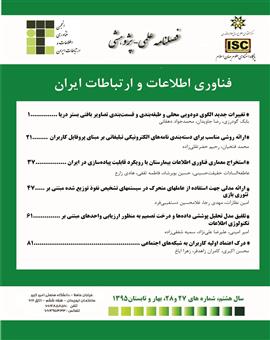ارائه مدلی جهت استفاده ازعاملهای متحرک در سیستم¬های تشخیص نفوذ توزیع شده مبتنی بر تئوری بازی
محورهای موضوعی : عمومىامین نظارات 1 , مهدی رجا 2 , غلامحسین دستغیبی فرد 3
1 - -دانشگاه تهران
2 - -دانشگاه الزهرا
3 - -
کلید واژه: عاملهای متحرک, IDS, تئوری بازی, سیستم چند عاملی, تعادل نش, مقدار شیپلی, امنیت شبکه,
چکیده مقاله :
سیستم های تشخیص نفوذ در شبکه، ابزارهایی هستند که به منظور محافظت از منابع شبکه در مقابل حملات استفاده می شوند. با توجه به گستردگی حملات در فضای اینترنت و تغییر در شکل و نوع حملات از حالت متمرکز به توزیع شده، معماری اینگونه سیستم ها نیز به سمت توزیع شدگی حرکت می کند. در این مقاله روشی مبتنی برعاملهای متحرک که به عنوان سنسورهای تشخیص دهنده حرکات غیر معتبر عمل می کنند پیشنهاد شده است. عاملهای متحرک تشخیص دهنده حمله به صورت پراکنده در شبکه در حال جابجایی از یک گره به گره دیگر می باشند و در هر زمان یک شبکه فوقانی امنیتی را ساخته و با استفاده از نوعی بازی همکارانه و برقراری ارتباط با یکدیگر، پس از رسیدن به مقدار شیپلی می توانند میزان و منشاء حمله را تشخیص و گزارش دهند. در این مقاله روشی پیشنهاد شده است که WGA در یک بازی غیرهمکارانه با عنصر مهاجم سعی در برقراری یک ارتباط مکاشفه ای جهت محاسبه مقدار نش و رسیدن به حداکثر سودمندی را دارد تا بتواند ضمن تفکیک حملات و یا درخواستهای واقعی، میزان و شدت حمله را با کمک سایر WGA بدست آورد
Network intrusion detection systems are tools used to protect network resources from attacks. Due to the spread of attacks in the Internet space and the change in the form and type of attacks from centralized to distributed, the architecture of such systems is also moving towards distribution. In this article, a method based on mobile agents that act as sensors for detecting invalid movements is proposed. Mobile attack detection agents are scattered in the network moving from one node to another and at any time they build a security upper network and use a kind of cooperative game and communicate with each other, after reaching the Shipley value. They can detect and report the extent and origin of the attack. In this article, a method is proposed that WGA in a non-cooperative game with the attacking element tries to establish a revelation communication in order to calculate the value of Nash and reach the maximum utility, so that it can separate the attacks or real requests, the amount and intensity of the attack with Get help from other WGA
1. C. Symantec, “Symantec Corporation,” 10 08 2013. . Available: http://www.symantec.com/index.jsp.
2. P. H. V. L. R. J. Z. H. M. Mel, “An Overview of Issues in Testing Intrusion Detection Systems,” NIST, Gaithersburg, MD, 2002.
3. A. D. V. M. R. D. Keromytis, "SOS: An architecture for mitigating DDoS attacks," IEEE Communications, vol. 22, p. 176–188., 2004.
4. G. V. S. Suryawanshi, “Mobile Agent for Distributed Intrusion detection System in Distributed System,” International Journal of Artificial Intelligence and Computational Research (IJAICR.), p. , 2010.
5. M. A. M. S. M. A. K. &. M. R. M. I. Kamaruzaman Maskat, “Mobile Agents in Intrusion Detection System: Review and Analysis,” Modern Applied Science, جلد 5, شماره 6, pp. 218-231, Dec 2011.
6. R. B. a. P. Mell, “Intrusion detection systems,” 2012 . Available: http://www.snort.org/docs/nistids.pdf.
7. S. E. Schechter, "Computer Security Strength and Risk: A Quantitative Approach," PhD Thesis, Harvard University, 2004.
8. S. E. Schechter, “Toward econometric models of the security risk from remote attacks,” IEEE Security & Privacy, جلد 3, شماره 1, p. 40–44, 2005.
9. D. S. P. J. M. R. K. G. Shaw, “Inside the minds of the insider,” Security Management, جلد 43, p. 34–44., 1999.
10. T. B. T. Alpcan, “A game theoretic approach to decision and analysis in network intrusion detection,” IEEE Conference on Decision and Control, p. 2595–2600, 2003.
11. C.-K. W. Yi-Ming Chen, “A Game Theoretic Framework for Multi-agent Deployment in Intrusion Detection Systems,” Security Informatics, Annals of Information Systems, pp. 117-133, 2010.
12. D. R. B. Mishra, “Cost sharing in a job scheduling problem using the Shapley value,” 2005.
13. P. Z. Liu, “Incentive-basedmodeling and inference of attacker intent, objectives and strategies,” ACM Transactions on Information and System Security, جلد 8, p. 78–118., 2005.
14. A. S. S. Dixit, “Games of Strategy,” 2001. .
15. R. D. M. A. M. a. T. T. L. McKelvey, “Gambit: Software Tools for Game Theory,,” 2007. . Available: http://econweb.tamu.edu/gambit.
16. GAMBIT, “GAMBIT,” 7 2013. . Available: http://www.gambit-project.org/.


